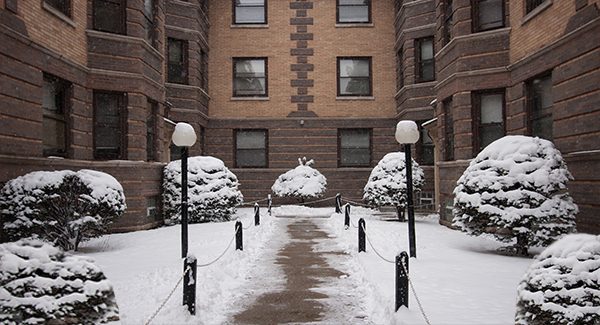Consider yourself lucky if your condominium, homeowner (HOA), or townhome community association has yet to experience leaks due to ice damming. With the incredible amount of snow that we have had this year and the inevitable warming, ice damming will occur in a number of community associations throughout the Midwest.
Ice damming generally occurs after a significant snowfall where a large amount of snow accumulates on the roof. After a sudden thaw, the gutters fill with melted snow. When the melted snow begins to freeze, there is a damming effect where the roof meets the gutter and where different roof elevations and angles meets. The melting snow has nowhere to go. Therefore, it seeps back under the shingle and sub-roof on the way to the building’s interior ceilings, walls and floors.
As you can imagine, the results of ice damming can be devastating. Generally, there is extensive water damage throughout the building. In combating the effects of ice damming, the Board must contend with the following:
Determine Responsibility
The Board must determine whether the damage to the building is the responsibility of a unit owner or the Association. Generally the Association will be required to repair and/or replace damage to roofs, gutters and other portions of the exterior of the building.
In addition, the Association will have to repair damage to the walls, floors and ceilings in the hallways as well as the carpeting in the hallways. The difficult issues are whether the Association or the unit owners have the responsibility to repair or replace the walls, floors and ceilings which serve their unit.
As the owners are generally required to maintain, repair or replace the unit, a careful reading of the Declaration and Plat of Survey is necessary to determine the exact boundaries of the unit.
Insurance Coverage
If the damage is quite extensive, the Association may want to file a claim with its insurance company. Generally, damage due from ice damming is covered by insurance. The extent of coverage will differ depending on the policy.
The good news is that most claims we have dealt with are covered by insurance. Owners who experience extensive damage to their units should also be advised to file a claim with their insurance company. If there is overlapping coverage between the Association’s and owner’s insurance policy, the respective insurance companies should attempt to work out a suitable resolution.
If the Board believes that the insurance company is not paying the claim in accordance with the policy, the Board should consult an expert to negotiate the claim on the Association’s behalf. A public adjuster may be of assistance and their fee is generally a portion of the additional funds they are able to receive for the Association.
Finding the Leaks
The Board should attempt to determine why there were leaks. Although the cause of ice damming is an act of God, there are certain procedures that the Association can perform to limit the amount of water that leaks into the building and the damage that occurs.
For instance, adding insulation or increasing the ventilation of the roofs tends to help prevent ice damming. In addition, there could be a design flaw with the roofs which creates ice damming. If your Association does experience ice damming, I suggest that you consult with a roofing expert who can make recommendations as to how to help alleviate this problem in the future.
Legal Resource
Hopefully your buildings will stay dry this winter and not experience the above problems. However, knowing how to deal with the problem and taking steps to prevent ice damming will make the cold winter months more manageable. Do not hesitate to contact our law firm if you are a property manager or property manager with legal questions about ice damming, property damage, insurance coverage, and maintenance responsibilities.
Since 1983, KSN has been a legal resource for condominium, homeowner, and townhome associations. Additionally, we represent clients in real estate transactions, collections, landlord/tenant issues, and property tax appeals. We represent thousands of clients and community associations throughout the US with offices in several states including Florida, Illinois, Indiana, and Wisconsin.
If our law firm can be of assistance, please call 855-537-0500 or visit www.ksnlaw.com.
Note: Originally published in the Pioneer Press (January 2001)
Please note the material contained in this article is for educational and informational purposes only and does not constitute legal advice. No attorney-client relationship is established by your review or receipt of the information contained in this article. You should not act on the information discussed in this article without first obtaining legal advice from an attorney duly licensed to practice law in your State. While KSN has made every effort to include up-to-date information in this article, the law can change quickly. Accordingly, please understand that information discussed in this article may not yet reflect the most recent legal developments. Material is not guaranteed to be correct, complete, or up to date. KSN reserves the right to revise or update the information and statements of law discussed in the article law at any time, without notice, and disclaims any liability for your use of information or statements of law discussed on the article, or the accessibility of the article generally. This article may be considered advertising in some jurisdictions under applicable law/s and/or ethical rules/regulations. © 2024 Kovitz Shifrin Nesbit, A Professional Corporation.

